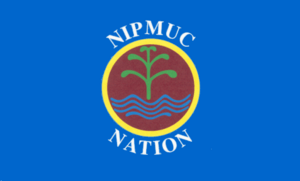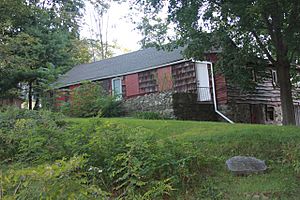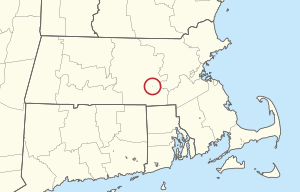Hassanamisco Nipmuc facts for kids

The Hassanamisco Nipmuc people are part of a larger tribe known as the Nipmuc Nation. They own a special piece of land, about three and a half acres, in Grafton, Massachusetts. These Native American people originally lived in Central Massachusetts, Northeastern Connecticut, and parts of Rhode Island.
In 1647, a religious leader named John Eliot created a "praying town" called Hassanamesit. Here, many Nipmuc people became Christians. Later, in 1727, a Nipmuc woman named Sarah Robins took over this land. She started a tradition where women in her family would inherit the land for many generations. During the mid-1600s, many Nipmuc people, especially women, married African Americans. This often happened because both groups faced unfair treatment.
Today, nearly 600 Nipmuc tribe members live in Massachusetts. The Hassanamisco Reservation and the Cisco Homestead in Grafton are still important places for the Nipmuc people. They help connect them to their history and culture. In 2011, these lands were added to the National Register of Historic Places. This helps protect the land and keep it with the Nipmuc people. Since 1924, Powwows have been held every July at the Hassanamisco Reservation. Everyone, both Native and non-Native, is welcome to attend.
Contents
History of the Nipmuc People
The Nipmuc people are also called "fresh water people." They lived in many villages that were connected by friendships and trade. They once owned a huge amount of land. This land stretched across what is now central and eastern Massachusetts, and parts of Rhode Island and Connecticut. The Nipmuc people hunted, gathered, and grew their own food. Women in the tribe were in charge of preparing food. They also passed down important cultural knowledge to new generations. The homes they lived in, called wetus, could be moved. This meant the Nipmuc people were sometimes seen as "wanderers." They always took great care of the land where they lived.
Early Encounters with Europeans
Not much is known about the Nipmuc people before European settlers arrived. When the Pilgrims first came to Massachusetts in 1620, there were about 6,000 Nipmuc people. The first known meeting happened in 1621. The settlers and Native Americans were friendly then. For example, when the settlers were hungry, a tribe member brought them corn.
Praying Towns and Cultural Changes
In the mid-1600s, Hassanamesit became one of many "Praying Towns." These towns were set up by the Massachusetts Bay Colony and a group called the Society for the Propagation of the Gospel in New England. Their goal was to convert Native Americans, known as "praying Indians," to Christianity. They also wanted them to adopt European ways of living.
The Hassanamisco Reservation in Grafton, Massachusetts was briefly a praying town in 1728. It was called Hassanamesit then. In these towns, Native people were not allowed to practice their own traditions. They had to follow eight rules, or pay a fine. These rules even included how their hair should look. Men could not have long hair, and women had to tie theirs back. This was an effort to make Native people change their culture and become more like Europeans.
King Philip's War and Its Impact
Metacom, also known as King Philip, gathered many Native American tribes in New England. They fought against the colonists. Thousands of Native Americans died in this war, including members of the Nipmuc tribe. During the war, the Nipmuc, along with other tribes, attacked Brookfield and burned parts of Springfield, Massachusetts.
In August 1675, members of the Hassanamesit praying town were told they could not leave. This was because colonists worried they would join King Philip. Later that year, non-fighting Nipmuc people were moved to Deer Island in Boston harbor for the winter. More than half of them died from cold and hunger. After the war, Nipmuc tribe members who had joined King Philip were either killed or sold into slavery in the Caribbean.
Land Loss and Preservation Efforts
After King Philip's War ended, seven Nipmuc families returned. They are known today as the Hassanamisco Nipmuc people. Settlers sold Hassanamisco land without the Nipmuc people's permission. The Nipmuc were allowed to keep 1,200 acres. This land slowly got smaller as some Nipmuc people sold or leased it to settlers. This might have happened because many Nipmuc men died in wars.
From the 1720s to the 1740s, the Massachusetts Colony pressured the Nipmuc to sell their land. This was often a trick to get Native Americans into debt. Then, settlers could claim their land. The Hassanamesit Nipmuc lost some of their shared land this way. Their land continued to be sold in pieces until 1857. That year, Moses Printer sold his land to Harry Arnold. Since then, the remaining acres have been Nipmuc land. It is now known as the Hassanamisco Reservation.
Sarah Robins was from one of the original seven Nipmuc families. In 1727, Sarah took control of the land. She started a tradition of women inheriting the land. This lasted for hundreds of years. Later, in the late 1800s, women from the Cisco family became caretakers of the land. They worked hard to protect it. After 1857, Sarah Arnold Cisco's land was the last original piece of Nipmuc land. Her uncle, John Hector, had sold his land to live with other Native people. But Sarah Cisco decided to stay and fight for her land.
Intermarriage and Recognition Challenges
In the late 1900s, the Nipmuc tribe asked the U.S. Government for official recognition. They were denied. One reason for this denial might be linked to John Milton Earle. In 1859, Earle, a politician, became the Massachusetts Indian Commissioner. At that time, both Native Americans and African Americans faced unfair treatment. This shared experience brought them together.
African American men and Native American women often met while working in New England villages. These meetings often led to marriages. Sometimes, Native American women would buy their future husbands out of slavery. This meant both would be free, and any children they had would also be free. However, many white people in New England did not see children of mixed-race couples as truly Native American. The number of mixed marriages grew, especially after wars when many Native American men had died.
In 1861, John Earle wrote a report. He said that Native Americans could no longer be considered a tribe. He claimed this was because of their marriages with African Americans. He stated the tribe was no longer culturally unique or independent. This report was used in 2004 by the Office of Federal Acknowledgement. It was a reason to deny the Nipmuc people official federal recognition as a nation.
Current Status of the Nipmuc Nation

Today, nearly 600 Nipmuc tribe members live in the community. This makes them one of the largest Native American nations in New England. The land they own now is the only part left of the original Hassanamesit settlement. The reservation land has both open areas and woods.
The Nipmuc are recognized as a "state acknowledged tribe" by Massachusetts. However, they are not recognized as a nation by the federal government. In 1980, the Nipmuc people asked the Bureau of Indian Affairs for recognition. They were denied because they did not meet all the rules. For example, they could not show they had been a continuous "American Indian entity" since 1900.
Every July, the tribe holds its annual Nipmuc Powwow. There is singing, dancing, and a naming ceremony. Both Native Americans and non-Natives attend this event. In 2011, the reservation was placed on the National Register of Historic Places. This helps protect the land for Native Americans.
The Cisco Homestead
The Cisco Homestead is the main building on the Hassanamisco Reservation. Tribe members are currently working to restore it. The building was named after the Cisco family about 150 years ago. But it was built much earlier, in 1801. The Cisco Homestead is thought to be the oldest timber-framed building still used by Native Americans today.
For the Hassanamisco Nipmuc people, the homestead and the reservation land are very important. They remind them of all the challenges their people have overcome. They also symbolize hope for their future survival. Having a historic building on Nipmuc land helps make sure the reservation land will not be sold to people outside the Nipmuc tribe. Money from the Grafton Community Preservation Committee has helped with the homestead's restoration.
|



